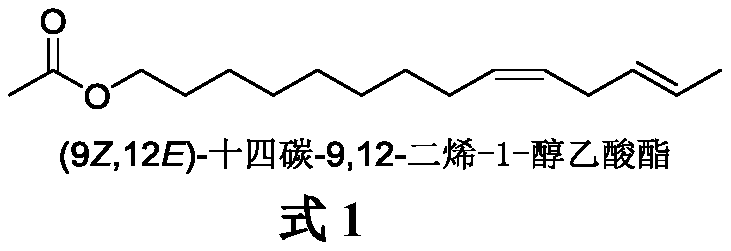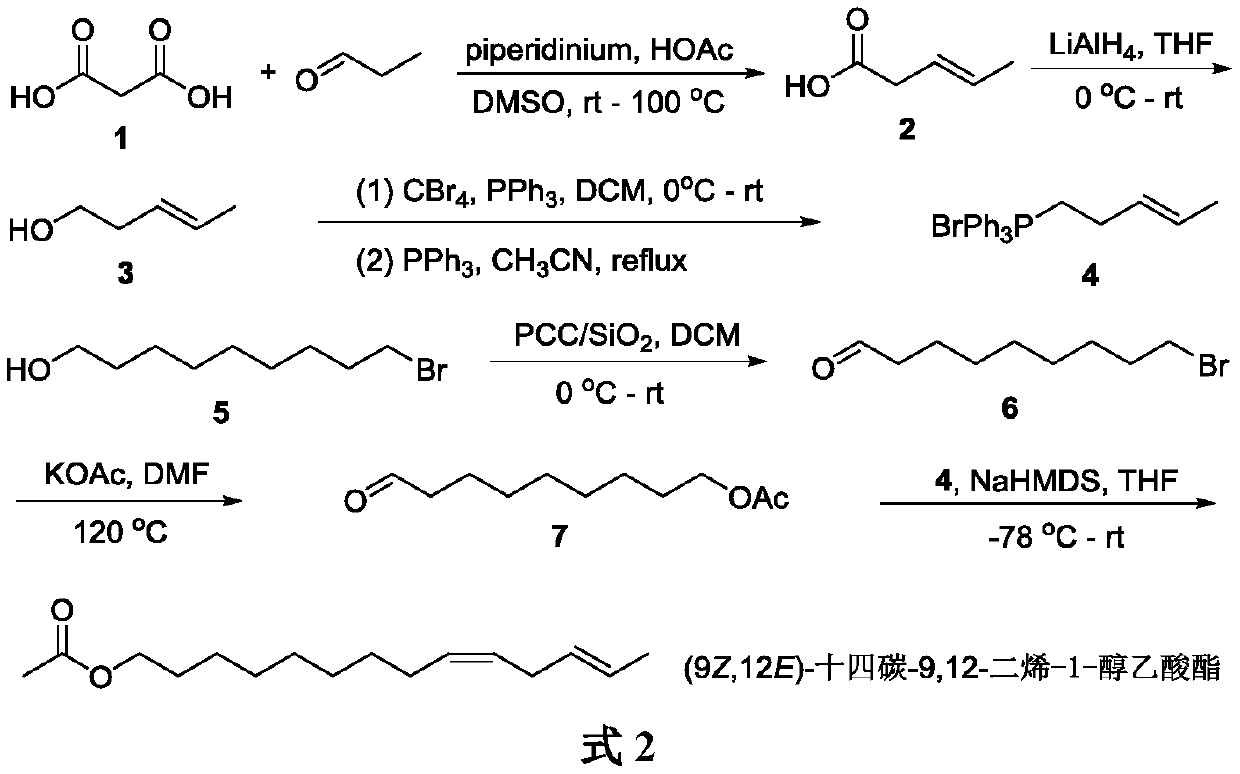Method for synthesizing (9Z, 12E)-9,12-tetradecadien-1-ol acetate
A technology of alcohol acetate and synthesis method, which is applied in the direction of carboxylate preparation, organic chemical method, chemical instrument and method, etc., and can solve the problems of reagent toxicity, lengthy reaction route, harsh reaction conditions, etc.
- Summary
- Abstract
- Description
- Claims
- Application Information
AI Technical Summary
Problems solved by technology
Method used
Image
Examples
Embodiment 1
[0027] Synthesis of (E)-3-pentenoic acid 2
[0028] Under argon protection, malonic acid (10.40g, 100mmol), piperidine (0.086g, 1mmol), glacial acetic acid (0.060g, 1mmol) and DMSO (40mL) were sequentially added to a 100mL three-necked flask equipped with a reflux condenser. , stirred at room temperature to dissolve, and slowly added propionaldehyde (2.90 g, 50 mmol) dropwise. After dropping, the temperature was raised to 40°C, and the reaction was stirred for 2h, then the temperature was raised to 100°C, and the reaction was continued for 8h. After the reaction, the reaction mixture was cooled to room temperature. The reaction was quenched by adding cold water (30 mL), and the layers were separated. The aqueous phase was extracted with diethyl ether (3 x 30 mL), and the organic phases were combined. The organic phase was washed successively with water (3×100 mL) and saturated aqueous sodium chloride solution (100 mL). After drying over anhydrous sodium sulfate, it was con...
Embodiment 2
[0030] Synthesis of (E)-3-penten-1-ol 3
[0031] Under the protection of argon, lithium aluminum tetrahydride (1.39 g, 36.62 mmol) was added into a 200 mL Schlenk reaction flask, and then tetrahydrofuran (60 mL) was added, and stirred evenly. A tetrahydrofuran solution (20 mL) of (E)-3-pentenoic acid 2 (2.82 g, 28.17 mmol) was slowly added dropwise under cooling in an ice bath. After dropping, the reaction mixture was gradually warmed to room temperature and stirred for 8 h. After the reaction was completed, 20% aqueous sodium hydroxide solution (3 mL) was slowly added dropwise under ice cooling to quench the reaction. The reaction mixture was suction filtered through celite, the filter cake was washed with ether (500 mL), and the filtrate was washed with water (50 mL) and saturated aqueous sodium chloride solution (100 mL) successively. After drying over anhydrous sodium sulfate, it was concentrated under reduced pressure to obtain a crude product. The crude product was pu...
Embodiment 3
[0033] Synthesis of (E)-3-pentenyltriphenylphosphine bromide 4.
[0034] Under argon protection, (E)-3-penten-1-ol 3 (2.00g, 23.22mmol), carbon tetrabromide (11.55g, 34.83mmol) and dichloromethane ( 60 mL), stirred at room temperature to dissolve. A dichloromethane solution (50 mL) of triphenylphosphine (18.27 g, 69.66 mmol) was slowly added dropwise under cooling in an ice bath. After dropping, the reaction mixture was naturally warmed to room temperature, and the stirring reaction was continued for 5 h. After the reaction, the reaction solution was concentrated to obtain a crude product. The crude product was suction filtered through diatomaceous earth, the filter cake was washed with ether (500mL), and the filtrate was concentrated under reduced pressure to obtain a light yellow liquid compound (E)-5-bromo-2-pentene crude product (2.98g, crude yield 86%).
[0035] Under argon protection, triphenylphosphine (2.64g, 10.07mmol), anhydrous acetonitrile (60mL) and crude (E)-...
PUM
 Login to View More
Login to View More Abstract
Description
Claims
Application Information
 Login to View More
Login to View More - R&D
- Intellectual Property
- Life Sciences
- Materials
- Tech Scout
- Unparalleled Data Quality
- Higher Quality Content
- 60% Fewer Hallucinations
Browse by: Latest US Patents, China's latest patents, Technical Efficacy Thesaurus, Application Domain, Technology Topic, Popular Technical Reports.
© 2025 PatSnap. All rights reserved.Legal|Privacy policy|Modern Slavery Act Transparency Statement|Sitemap|About US| Contact US: help@patsnap.com


